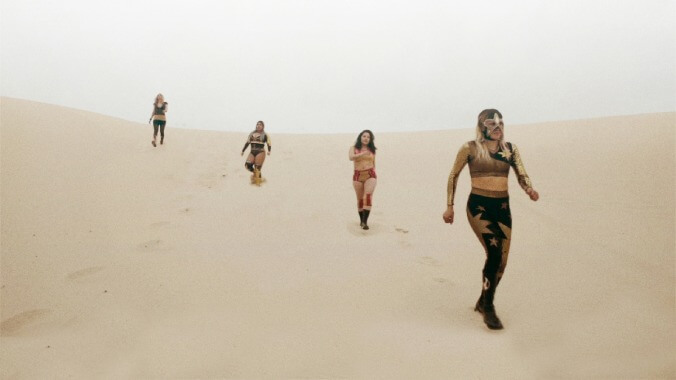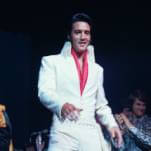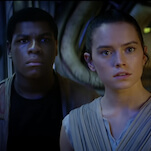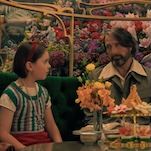Luchadoras in the sand dunes outside Ciudad Juarez Photo: SXSW
Alvin Toffler would have been horrified by the SXSW app. Toffler was talking about consumer choice—i.e., a dozen chocolate chip cookie brands on the shelves of a supermarket— when he coined the word “overchoice” in his 1970 book Future Shock, proposing that having too many options does not actually help a person make the right selection but in fact overloads their cognition so that they cannot make a decision at all. But us people of the future have much more overwhelming stimuli to contend with. An entire aisle of cereal? Ha! Try surfing a streaming service!
And SXSW, thanks to that hybrid identity we’ve been talking about over the last week, has one of the most hectic virtual platforms I’ve come across. It’s not that it’s unattractively designed, or that options are presented in a confusing way; in fact, the pink and green color scheme is both soothing to the eyes and on trend. It’s just that, between TV, film, keynotes, and Q&As, there’s just too much for one human being to look at in a week. That’s where word of mouth comes in, as critics compare notes and scramble to catch the titles that were pleasant surprises for their colleagues earlier in the festival.
One film that picked up buzz throughout this year’s virtual SXSW—enough to warrant its acquisition by Magnolia Pictures late in the week—is Swan Song, writer-director Todd Stephens’ ode to an LGBTQ+ elder from his hometown of Sandusky, Ohio. Udo Kier plays Mister Pat Pitsenbarger, a retired hairdresser in his 70s who’s shaken by the news that one of his former clients, a Republican socialite who publicly scorned Mr. Pat while privately calling him her best friend, has died. The woman left a $25,000 allowance in her will for Mr. Pat to do her hair at her funeral, a postmortem apology Mr. Pat isn’t sure he wants to accept. Regardless, he takes it as a sign and embarks on a crosstown odyssey from his nursing facility to the funeral home, stopping to visit the bar where he used to perform, the former assistant who drove him out of business, and his longtime partner’s grave along the way.
The last time I saw Udo Kier, he was playing an amoral mercenary leading a band of wealthy American tourists on a hunt for the most dangerous game in the Brazilian film Bacurau. And frankly, that’s a more on-brand role for Kier than Swan Song. The German B-movie legend is frequently typecast as a villain, and Stephens’ risky casting here both does and doesn’t pay off. On the one hand, you’ll never forget Udo Kier fixing his icy blue eyes on a gas station attendant and saying, “I know what you’re thinking. How can someone this flawless be on Social Security?” On the other, that’s one of the more successful combinations of actor and dialogue here, as some of Stephens’ wordier quips get mashed into applesauce by Kier’s accent.
The actor’s signature intensity does lend a unique magnetism to his character’s flamboyant mannerisms, successfully riding the line between pathos and camp. (See also: Jennifer Coolidge, playing it completely straight as the faithless former assistant.) Balancing those two impulses seems to be Stephens’ project for the film more generally, which is packed with colorful one-liners while aching for the loss of queer communal spaces and an entire generation devastated by AIDS. Mr. Pat was a real person whose mere existence as an openly gay man in small-town Ohio in the ’80s helped Stephens become the person and the filmmaker he is today. As tribute, Swan Song is tender and heartfelt.
Edgar Wright also comes to this year’s SXSW with a heartfelt tribute, but his had the benefit of riding in on a triumphant wave of hype. The Sparks Brothers premiered at this year’s Sundance, but it’s a perfect fit for SXSW, a festival with a higher music-docs-per-feature average than most festivals that don’t have the word “music” in the name. Along with The Sparks Brothers and the Demi Lovato and Poly Styrene projects I reviewed earlier this week, SXSW 2021 also featured the centerpiece film Tom Petty: Somewhere You Feel Free, a behind-the-scenes look at the recording of Petty’s 1994 classic Wildflowers that I found sweetly nostalgic but not especially insightful. (There’s also closing night film Charli XCX: Alone Together, which fell victim to the limited number of hours in this critic’s day.) The Petty documentary was clearly made with pre-existing fans in mind, but The Sparks Brothers openly pleads with viewers to give these guys a chance.
That’s because, in Wright’s words, Sparks is “successful, underrated, hugely influential, and criminally overlooked, all at the same time.” They certainly have a lot of famous fans: Everyone from Sex Pistols guitarist Steve Jones to “Weird” Al Yankovic appear in the film as talking heads, praising the duo’s cinematic sensibilities, forward-thinking compositions, and sardonic lyrical edge. I am admittedly one of those people who had heard the name Sparks but had never listened to their music. But after watching this enthusiastic 140-minute retrospective/sales pitch, I can confidently say that, given how many times brothers Russell and Ron Mael have changed their sound over the past 50 years, there’s a Sparks album for everybody. (I liked their synth-pop phase, personally.) Watching a documentary about a band can be excruciatingly boring if you’re not already a fan, but self-proclaimed “fanboy” Wright seems to have anticipated this as well, as The Sparks Brothers is full of lively montage and tongue-in-cheek meta touches.
Giving the unknown a chance is a good policy for film festivals as well as musical tastes, as I learned watching four films—two highly anticipated, two based on pure word of mouth—at SXSW. Andrea Riseborough is excellent in everything she does, which propelled the Northern Irish film Here Before to the top of my list; by the end of this classic “is she crazy, or is everyone conspiring against her?” psychological thriller, however, I had to admit that the film’s slow burn and minimalist exposition made it an exquisitely shot, brilliantly acted bore. On the other hand, I added the Norwegian comedy Ninjababy to my list at the last minute, and was stunned to see a perspective shared by many people I know but rarely depicted on screen—that a fetus is not a precious miracle but an annoying, errant sperm squatting in someone’s uterus—with both honesty and warmth.
On the documentary side, too, my predictions were proven wrong. I was looking forward to the FX doc Hysterical, based on the idea that it wouldn’t be out to prove that women “really are funny!”—that it might take that as a given and proceed from there. But although that particular low bar as been cleared, Hysterical is still an elementary survey of the struggles of women in stand-up that glides over the surface of much of its most interesting material in favor of trite (if true) declarations of the power of women supporting women. Luchadoras, on the other hand, makes a similar point in more poetic fashion, by following four female lucha libre athletes in the Mexican border city of Ciudad Juarez. Women go missing in Ciudad Juarez in chillingly large numbers, and have for decades. Amid this ongoing femicide, directors Paola Calvo and Patrick Jasim depict how women in the city refuse to submit to fear through solidarity, self-defense, and, yes, sport. By the end of the documentary, an image of a bloodied and bruised luchadora holding up an opponent’s mask after winning a fight gains a profound and affecting resonance.
Opening this dispatch with a comment on the staggering amount of content contained within SXSW’s second virtual edition, then going on to talk about films that took me by surprise, probably isn’t very helpful for someone trying to navigate similar festivals in the future. Sorry about that. The best I can say is that while a virtual festival is missing certain aspects of the film-festival experience—the big-screen experience and the in-person camaraderie most of all—it also gives attendees more room to be spontaneous. Where in person, you might have to trek across town or switch out tickets to check out that under-the-radar selection everyone’s been talking about, on an app those films are just a few clicks away. Sure, I miss the parties, but that ease of discovery offers its own kind of magic.









































